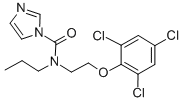Prochloraz 咪鲜胺
Introduction: Prochloraz is an imidazole fungicide that is widely used in Europe, Australia, Asia and South America for gardening and agriculture. It can be used alone or in combination with other agents in case of fungal infestation of cereals. It is frequently used in the seed dressing to prevent fungal diseases of many crops, including oilseed rape, sugar beet, vegetables, rice and coffee, as well as for the protection of citrus fruits during storage and transport. Screening studies have shown that prochloraz elicits multiple mechanisms of action in vitro, as it antagonizes the androgen and the oestrogen receptor, agonizes the Ah receptor and inhibits aromatase activity. In vivo prochloraz acts as an antiandrogen.
Common name: Prochloraz
Another name: Mirage; Octave; Prelude; Ascurit; Sporgon; Sportak; Mirage (pesticide); Dibavit; Sprint; Omega; Sportak PF; etc.
Chemical name: N-propyl-N-[2-(2,4,6-trichlorophenoxy)ethyl]imidazole-1-carboxamide
Empirical formula: C15H16Cl3N3O2
Structural formula:

Mol. Weight: 376.7 g/mol
CAS No.: 67747-09-5
Specifications
Leading Prochloraz supplier
Prochloraz 95% TC
Prochloraz 98% TC
Prochloraz 450 g/L EW
Prochloraz 250 g/L EC
Packing:
BULK PACKING
Powder: 25kg/Bag, 25kg/Drum, 50kg/Drum etc.
Liquid: 200L/Drum, 20L/Drum, 10L/Drum etc.
SMALL PACKING
Powder: 1kg/Alu bag, 500g/Alu bag, 200g/Alu bag, 100g/Alu bag, 50g/Alu bag, 15g/Alu bag etc.
Liquid: 5L/Drum, 1L/Bottle, 500ml/Bottle, 250ml/Bottle, 100ml/Bottle, 50ml/Bottle etc.
Customerized packing label
Prochloraz FAO standard
Professional registration
HAZARDS IDENTIFICATION
Hazard statement(s)
H302 (100%): Harmful if swallowed.
H332 (12.1%): Harmful if inhaled.
H400 (100%): Very toxic to aquatic life.
H410 (100%): Very toxic to aquatic life with long lasting effects.
Precautionary statement(s)
P261: Avoid breathing dust/fume/gas/mist/vapors/spray.
P264: Wash ... thoroughly after handling.
P270: Do not eat, drink or smoke when using this product.
P271: Use only outdoors or in a well-ventilated area.
P273: Avoid release to the environment.
P301+P312: IF SWALLOWED: call a POISON CENTER/doctor/... IF you feel unwell.
P304+P312: IF INHALED: Call a POISON CENTER/doctor/... if you feel unwell.
P304+P340: IF INHALED: Remove person to fresh air and keep comfortable for breathing.
P312: Call a POISON CENTER or doctor/... if you feel unwell.
P330: Rinse mouth.
P391: Collect spillage.
P501: Dispose of contents/container to an approved waste disposal plant.
Supplemental Hazard Statements: none.
MAMMALIAN TOXICOLOGY
Acute toxicity: 1) Acute oral LD50 for rats is 1023 mg/kg. 2) Acute dermal LD50 for rats is >2100 mg/kg. 3) Acute inhalation toxicity LC50 (4 h) for rats is >2.16 mg/L. 4) Skin irritation: Slightly irritating to skin (rabbits). 5) Eye irritation: Non-irritating to eyes (rabbits). 6) Skin sensitization for guinea pig: Not a sensitizer.
NOEL: (2 y) for rats is 1.3 mg/kg/day; (2 y) for mice is 7.5 mg/kg/day. Other Not genotoxic. Not carcinogenic.
ADI (JMPR) 0-0.01 mg/kg b.w. [2001]
Classification:
WHO Classification: II (Moderately hazardous)
EC Risk Classification: Carcinogen category 3: R40; Reproduction risk category 3: R63; Xn - Harmful: R22; N - Dangerous for the environment: R50, R53.
US EPA Classification (formulation): No consensus across products or no products available.
ECOTOXICOLOGY
Effect on birds: Acute oral LD50 for Bobwhite quail is 662 mg/kg. Effect on fish: Acute LC50 (96 h) for Rainbow trout is 1.5 mg/l. Effects on aquatic invertebrates: Acute EC50 (48 h) for Daphnia magna is 4.3 mg/l. Effects on algae: Acute 72 hour EC50 for Scenedemus subspicatus is >0.0055 mg/l. Effects on bees: contact acute 48 hour LD50 is 141.3 μg/bee, oral acute 48 hour LD50 is >101 μg/bee. Effects on earthworms: Acute 14 day LC50 is >500 mg/kg.
ENVIRONMENTAL FATE
Animals In all species examined, prochloraz is rapidly metabolised initially by cleavage of the imidazole ring and quantitatively eliminated from the body, following oral administration. Whilst absorption following dermal exposure is low, residues in plasma and tissues are again rapidly eliminated from the body. Plants The primary plant metabolite, N-formyl-N'-1-propyl-N-(2-(2,4,6-trichlorophenoxy)ethyl)urea, is formed from cleavage of the imidazole ring. This is degraded to N-propyl-N-(2-(2,4,6-trichlorophenoxy)ethyl)urea, which occurs in both free and conjugated forms. Other metabolites include 2-(2,4,6-trichlorophenoxy)ethanol, 2-(2,4,6-trichlorophenoxy)acetic acid, traces of 2,4,6-trichlorophenol and conjugates of the above. Little unchanged prochloraz is present. Soil/Environment Degrades in the soil to a range of mainly volatile metabolites (degradation is not pH-dependent). Prochloraz is well adsorbed onto soil particles, and is not readily leached; Kd 152 (sandy loam), 256 (silty clay loam). In a further study, mean Koc 1463. Possesses low toxicity to a wide range of soil microflora and microfauna, but has inhibitory effects on soil fungi. DT50 under field conditions is 5-37 d.
Usage: Prochloraz was introduced by The Boots Co., Ltd (now Bayer CropScience). It is a fungicide active against a wide range of diseases affecting cereals, field crops, fruit and many other crops.
Application: Biochemistry Steroid demethylation (ergosterol biosynthesis) inhibitor. Mode of action Fungicide with protective and eradicant action. Uses A protectant and eradicant fungicide effective against a wide range of diseases affecting field crops, fruit, turf, and vegetables. An EC is recommended for use in cereals (400-600 g a.i./ha) against Pseudocercosporella, Pyrenophora, Rhynchosporium, and Septoria spp., with useful activity against Erysiphe spp.; in oilseed rape (500 g/ha) against Alternaria, Botrytis, Pyrenopeziza and Sclerotinia spp. Useful activity is also shown against Ascochyta and Botrytis spp. in field legumes; and Cercospora and Erysiphe spp. in beet. Good activity against storage or transit diseases of citrus and tropical fruit when applied as a dip treatment (0.5-0.7 g/l). A WP is recommended in mushrooms against Verticillium fungicola and Mycogone perniciosa, and in rice against Pyricularia. A seed treatment (0.2-0.5 g/kg) will control several cereal diseases caused by Cochliobolus, Fusarium, Pyrenophora and Septoria spp., and, in flax, Alternaria.
| 






